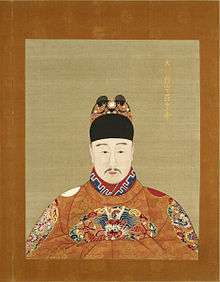Longqing Emperor
| Longqing Emperor | |||||||||||||||||
|---|---|---|---|---|---|---|---|---|---|---|---|---|---|---|---|---|---|
 | |||||||||||||||||
| 12th Emperor of the Ming dynasty | |||||||||||||||||
| Reign | 4 February 1567 – 5 July 1572 | ||||||||||||||||
| Predecessor | Jiajing Emperor | ||||||||||||||||
| Successor | Wanli Emperor | ||||||||||||||||
| Born | 4 March 1537 | ||||||||||||||||
| Died | 5 July 1572 (aged 35) | ||||||||||||||||
| Burial | Zhaoling, Ming Dynasty Tombs, Beijing, China | ||||||||||||||||
| Spouse |
Empress Xiaoyizhuang Empress Xiao'an Empress Xiaoding | ||||||||||||||||
| Issue | Wanli | ||||||||||||||||
| |||||||||||||||||
| House | House of Zhu | ||||||||||||||||
| Father | Jiajing Emperor | ||||||||||||||||
| Mother | Empress Xiaoke | ||||||||||||||||
The Longqing Emperor (simplified Chinese: 隆庆; traditional Chinese: 隆慶; pinyin: Lóngqìng; 4 March 1537 – 5 July 1572), personal name Zhu Zaihou (朱載垕), was the twelfth emperor of the Ming dynasty of China from 1567 to 1572. He was initially known as the Prince of Yu (裕王) from 1539 to 1567 before he became the emperor. His era name, Longqing, means "great celebration".
Reign
After the death of the Jiajing Emperor, the Longqing Emperor inherited a country in disarray after years of mismanagement and corruption. Realizing the depth of chaos his father's long reign had caused, the Longqing Emperor set about reforming the government by re-employing talented officials previously banished by his father, such as Hai Rui. He also purged the government of corrupt officials namely Daoist priests whom the Jiajing Emperor had favoured in the hope of improving the situation in the empire. Furthermore, the Longqing Emperor restarted trade with other empires in Europe, Africa and other parts of Asia. Territorial security was reinforced through the appointment of several generals to patrol both land and sea borders. This included the fortification of seaports along the Zhejiang and Fujian coast to deter pirates, a constant nuisance during the Jiajing Emperor's reign. The Longqing Emperor also repulsed the Mongol army of Altan Khan, who had penetrated the Great Wall and reached as far as Beijing. A peace treaty to trade horses for silk was signed with the Mongols shortly thereafter.
The Longqing Emperor's reign, which was not unlike that of any previous Ming emperor, saw a heavy reliance on court eunuchs. One particular eunuch, Meng Cong, who was introduced by the Longqing Emperor's chancellor Gao Gong, came to dominate the inner court towards the end of the emperor's reign. Meng Cong gained favours by introducing Nu Er Huahua, a female dancer of ethnic Turkish origin, to the Longqing Emperor, whose beauty was said to have captured the ruler's full attention. Despite initial hopeful beginnings, the Longqing Emperor quickly abandoned his duties as a ruler and set about pursuing personal enjoyment. The emperor also made contradictory decisions by re-employing Daoist priests that he himself had banned at the start of his reign.
Death and legacy
The Longqing Emperor died in 1572 and was only 35. Unfortunately, the country was still in decline due to corruption in the ruling class. Before the Longqing Emperor died, he had instructed minister Zhang Juzheng to oversee affairs of state and become the dedicated advisor to the Wanli Emperor who was only 10.
The Longqing Emperor's reign lasted a mere six years and was succeeded by his son. It was said that the emperor also suffered from speech impairment which caused him to stutter and stammer when speaking in public.[1] He is generally considered one of the more liberal and open-minded emperors of the Ming dynasty, even though he lacked the talent keenly needed for rulership and he eventually became more interested in pursuing personal gratification rather than ruling itself.
The Longqing Emperor was buried in Zhaoling (昭陵) of the Ming Dynasty Tombs.
Children
- 1.- Zhu Yi (15 October 1555 – 11 May 1559), son of Empress Lizhuang.
- 2.- Zhu Yixun (1563-1567), the Wanli Emperor.
- 3.- Zhu Yiling (1565-1566).
- 4.- Zhu Yiliu (1568-1614), Prince of Lu.
References
| Wikimedia Commons has media related to Longqing Emperor. |
| Longqing Emperor Born: 4 March 1537 Died: 5 July 1572 | ||
| Regnal titles | ||
|---|---|---|
| Preceded by The Jiajing Emperor |
Emperor of China 1567–1572 |
Succeeded by The Wanli Emperor |